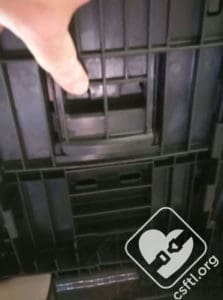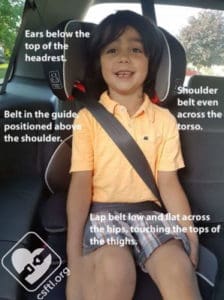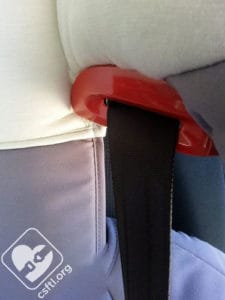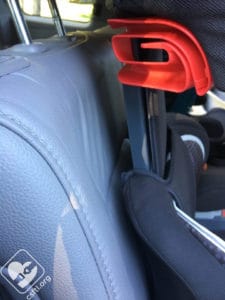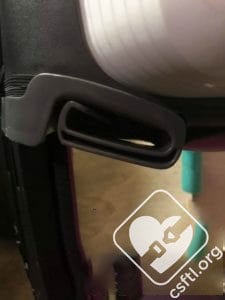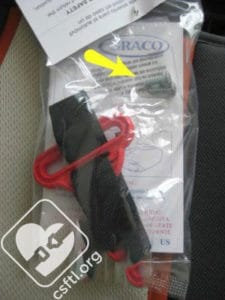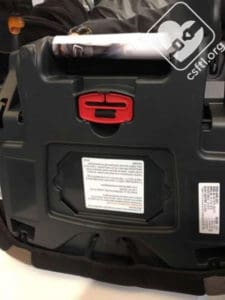Booster seats are essential safety equipment for our older children. As we know, most children need seat belt positioning boosters until they are 10-12 years old: for most kids that will mean they will start out with a high back booster once they’ve outgrown their harnessed car seat, then move on to a backless booster when they’ve outgrown the back on their high back boosters.
Quick aside: did you know that the back on your child’s high back booster will raise up and grow along with them? Most do this with the squeeze of a handle on the back of the headrest!
Booster seats can seem SO EASY after years of struggling to install harnessed car seats. Just grab one from the store shelf, plop it onto the vehicle seat, have your kiddo take a seat, then buckle themselves in. Right? We wish. But the reality is, we see a stunning rate of misuse in the booster aged crowd.
Some common misuses are:
- Not raising the booster’s headrest as the child grows
- Routing the lap or shoulder belt through the wrong place
- Not routing the shoulder belt through the shoulder belt guide (if it’s required)
- Moving a child out of a booster seat WAY too soon
- Moving a young child out of a booster and directly to the front vehicle seat
We’d like to educate around all of these issues and inspire caregivers around the globe to change their habits to align with best practice. Let’s start by looking at how booster seats work and exploring the ways a shoulder belt guide adjuster can help position the vehicle seat belt correctly over the child’s shoulder.
How Booster Seats Work
Booster seats work by positioning the lap portion of the vehicle seat belt low on the child’s hips, contacting the thighs. In addition, booster seats also align the shoulder portion of the vehicle seat belt on the center of the child’s shoulder, and should lay flat and snug across the collarbone.
Until a child passes the Five Step Test to fit properly in the vehicle seat belt alone, a booster seat places the child and the vehicle seat belt in the correct position so that in the event of a collision or even a quick stop, the vehicle seat belt will restrain the child using these big bones, rather than the cutting into the squishy organs of the abdomen.
Seat belt syndrome is when the vehicle seat belt doesn’t stop on those big bones but on the child’s internal organs instead. It’s this type of often-lethal injury that we see among children who have been moved out of their boosters too soon. And it’s this type of injury that we’d desperately like to prevent. This increase in abdominal injuries in children who are 7 years old — a time when many parents inaccurately believe that children no longer require a booster — weighs heavily on our minds.
High Back Boosters: Thread the Shoulder Belt
Kids come in all shapes and sizes. That’s why many booster seats include shoulder belt adjusters that can help place the shoulder belt correctly over the child’s collarbone. For high back boosters, the shoulder belt adjuster is usually built into the seat, we typically call this a shoulder belt guide. To do its job, the shoulder portion of the belt only needs to be threaded through the belt adjuster and the booster seat’s headrest properly raised for the child’s height.
The shoulder belt adjuster on this Maxi Cosi booster is red, and the slit to slide the shoulder belt through is on the side. Once the shoulder portion of the belt is through the guide, we used the handle on the back to adjust the booster’s height so that the child’s shoulders are right under the guide and the shoulder belt lies flat on the shoulder.
The shoulder belt adjuster on the Graco Turbobooster is also red, but the slit to slide the shoulder belt through is somewhat more complex. If you didn’t turn this booster to the side, you might miss the essential step of threading the shoulder belt adjuster. Once you thread the shoulder belt check to make sure that it isn’t twisted, adjust the booster so that the child’s shoulder is just below the guide, and you’re ready to buckle and go.
The shoulder belt adjuster on this Evenflo Spectrum booster is grey, so don’t overlook it in a dark car! Thread the shoulder belt in, adjust the booster’s headrest using the handle on the back of the seat, buckle and go.
Backless Boosters: Belt Guide Behind the Child’s Back
Once children outgrow their high back booster seat, all but the most tallest will still need a backless booster. before the vehicle seat belt fits them properly If your older booster rider hops on their backless booster, buckles the vehicle seat belt properly, and still finds that the shoulder belt is on their neck, don’t despair!
Many backless boosters also come with shoulder belt adjusters: these are simple red belt guides on webbing straps that sit behind the child and help keep the shoulder belt in the middle of the collarbone, not on the child’s neck or falling off the side of their shoulder.
The belt adjusters on backless boosters are often overlooked by parents eager to get their new booster seat into the car. Though booster seats are generally easier to assemble and set up than harnessed car seats, some assembly is sometimes required.
For example, the shoulder belt guide adjuster on this backless Graco Turbo booster came attached to the manual in a plastic bag: don’t throw out that bag! It may also include screws which must be installed in the armrests.
Follow your booster seat’s manual to see how to attach the shoulder belt guide to the booster seat. Then thread the vehicle seat belt through the red guide and adjust so your booster rider gets a good shoulder belt fit.
The shoulder belt adjuster on this Chicco GoFit can be cleverly hidden on the bottom of the seat. To use it, thread the seat belt through the red guide and adjust the webbing until the shoulder belt fits your big kid.
Final Thoughts
If we leave you with one tidbit of information, let it be that booster seats can be harder to use than they appear. Spend a little time getting your booster rider properly set up, then help their booster grow with them until they can pass the Five Step Test.

